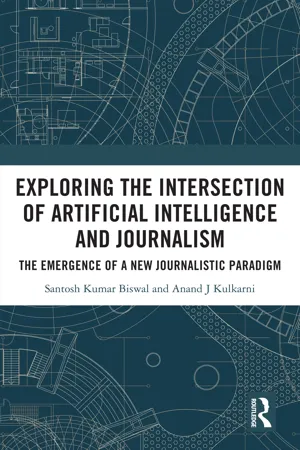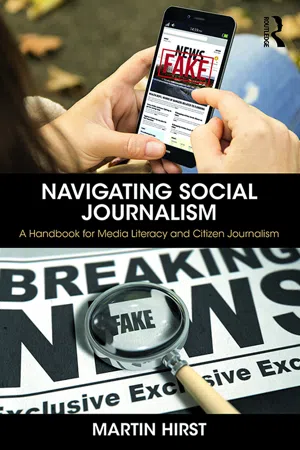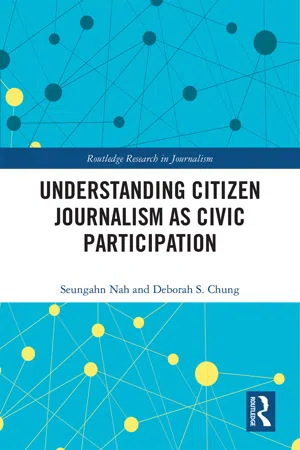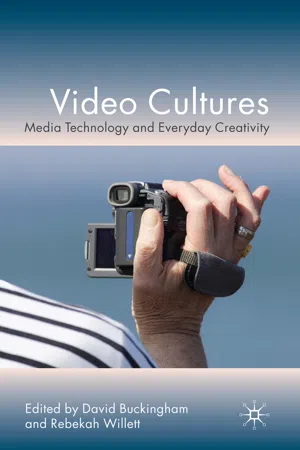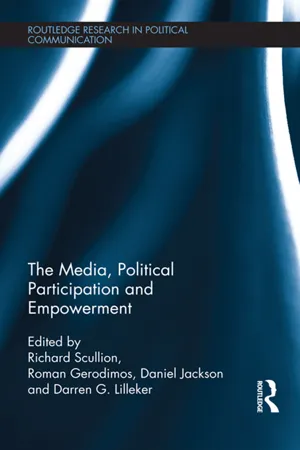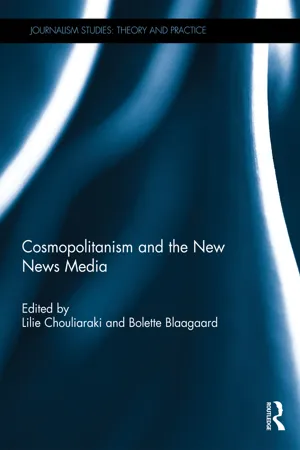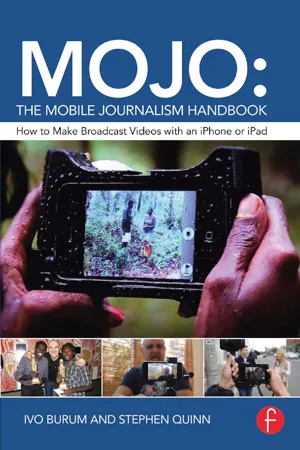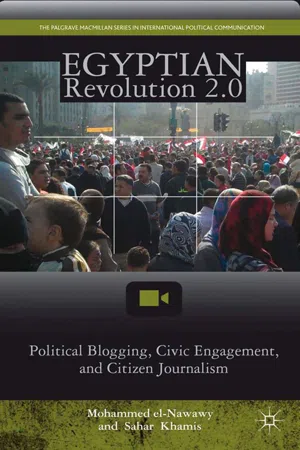Politics & International Relations
Citizen Journalism
Citizen journalism refers to the practice of ordinary individuals, rather than professional journalists, engaging in the collection, reporting, and analysis of news and information. Enabled by digital technology and social media platforms, citizen journalism has the potential to provide diverse perspectives and grassroots coverage of political events, often challenging traditional media narratives and offering a more democratic approach to news dissemination.
Written by Perlego with AI-assistance
Related key terms
1 of 5
12 Key excerpts on "Citizen Journalism"
- eBook - PDF
Political Communication in Postmodern Democracy
Challenging the Primacy of Politics
- K. Brants, K. Voltmer, K. Brants, K. Voltmer(Authors)
- 2011(Publication Date)
- Palgrave Macmillan(Publisher)
Citizen Journalism In contrast to participatory journalism, we categorize independent or autonomous activities as Citizen Journalism, which thus can be considered publishing by non-professional journalists (amateurs, lay people, ‘citizens’) with or without limited editorial control from professionals. Well-known examples are photos and videos that are uploaded to media platforms like YouTube and Flickr, where there is only control with regard to copyright issues and publication of illegal or obscene material. Collaborative news sites, like Wikinews and Indymedia, also exert little or no prior control over what is being published and actively call upon their readers to edit and contribute to stories that have been submitted by users. Apart from factual contributions, there are many forms of citizen activities that are more or less interactive and interpersonal in nature. While these may have less direct journalistic value, the popularity of the myriad possibilities for public and private discussions on the Web continues to increase, with the spectacular growth in usage of Twitter and Facebook (Solis, 2009; Nielsen Company, 2010). Many news organi- zations are increasing their presence on networks’ sites, forums and 190 The New Frontiers of Journalism Twitter in order to tap into the buzz and conversations about particular topics and use it as vox populi in their news coverage. Citizen participation in the UK Given the focus of this volume, it is useful to elaborate somewhat fur- ther on the nature of citizen involvement in the journalistic process in both the UK and the Netherlands. Continuing first with the theme of participatory journalism, as Wahl-Jorgensen (2002) found in her study of letters to newspaper editors, journalists still widely perceive ‘user comment’ as unrepresentative of their audience and indicative of a dan- gerous fringe opinion that they feel they should not publish. - eBook - PDF
Citizen Journalism
Global Perspectives- Volume 2
- Einar Thorsen, Stuart Allan(Authors)
- 2013(Publication Date)
It is in this context that NYU journalism professor Jay Rosen’s definition of Citizen Journalism is most applicable—“when the people formerly known as the audience employ the press tools they have in their possession to inform one another” (Rosen, 2008). Today, the spread of information is no longer one directional, top down, from mainstream media to the masses. Internet technologies empower individuals as members of a many-to-many net- work of “self-communication,” enabling conversation and coordination using a variety of mobile and online media, including blogs as well as social networking sites, blurring traditional boundaries between producers and consumers of infor- mation, reducing the power of information gatekeepers, and building networks of communication and organization that span the globe. The ramifications of technological change, however, are determined not merely by what the technologies enable, but how and by whom they are used. The impact of online and mobile media on journalism and society, I argue, is culturally and nationally specific. The significance of “Citizen Journalism” depends on the socio-political context, and a nation’s understanding of the role of the citizen and of journalism itself. By examining specific local contexts, scholars can go beyond universal assumptions to consider the socially and politically situated relation- ship between online media, information and individuals. Thus developing a more nuanced assessment of the implications of online and mobile media on the role of public affairs reporting, and on social and political action. This approach un- derscores the importance of expanding theories of new media beyond US-centric models, or models that universalize US-centric assumptions about the interplay between online media, journalism and the public. - eBook - PDF
- Leara D. Rhodes(Author)
- 2018(Publication Date)
Technology driven changes have reshaped how international news flows by lowering the economic barriers of entry to publishing and broadcasting and encouraging the proliferation of nontraditional international news sources. Citizens, for a variety of reasons, began covering conflict due to losing trust in traditional media, to having new opportunities for expressing a viewpoint and to living in an area not safe for foreign correspondents. These citizen journalists are providing images and stories that are changing how news is pro- duced. A group of disconnected digital activists in Iran realized they had the technical ability to get textual and visual information out to the public. These individuals or citizen journalists began distributing content to members of the international press and general public via social networking sites. Specifically, Twitter was heavily used. It gave protestors the opportunity to reach audienc- es beyond Iran (“Editorial: Iran’s Twitter,” 2009). As a result, Western media such as Newsweek magazine suggested that the 2009 post-Iranian election was the “true birthplace of Citizen Journalism” (Human Rights Watch, 2010). The Iranian government, however, quickly unleashed a widespread crackdown and the revolution eventually failed. Citizens report through blogs, Facebook, and tweets. A blogger became a major news source for BBC during the early days of the conflict unfolding in Baghdad. Salam Pax’s blog, “Where is Raed?” (Dear-raed.blogspot.com) became internationally popular. That popularity, however, became a problem with traditional journalists who have expressed the difficulty of sorting out the authentic and factual from the errors, rumors, and misinformation. Tradition- al journalists mistrust participatory journalism and believe that it “threatens to undermine what they consider core values” such as editorial control and objectivity (Gillmor, 2004, p. 114). - eBook - ePub
Exploring the Intersection of Artificial Intelligence and Journalism
The Emergence of a New Journalistic Paradigm
- Santosh Kumar Biswal, Anand J. Kulkarni(Authors)
- 2024(Publication Date)
- Routledge India(Publisher)
It is apparent that such type of journalism has become instrumental in terms of collecting, reporting, analyzing and disseminating the news contents to the citizens. However, Citizen Journalism is usually termed as contextual. It works differently for different people in diverse political and cultural setups. Technological upgradations have the bearings on the origin and growth of such unique form of journalism.AI, a form of innovation, remains a buzzword in the field of technologies. However, its applications are apparent in almost all the professional fields. The field of journalism is not exception to it. Journalists in the newsrooms are exploring the implications of AI. AI in journalism is vastly making inroads in the landscape of breaking news, investigating the facts, curbing fake news, interactive news and the like. However, since Citizen Journalism otherwise known as participatory or collaborative form of journalism is somewhat different from mainline journalism, the implications of AI on citizens, participatory nature of journalism and society needs a series of deliberations.9.2 Origin, History and Growth of Citizen Journalism
Tracing, understanding and making conclusive remarks on the origin and history of Citizen Journalism remains fussy. A study finds that Citizen Journalism commenced globally in the early 2000s when common citizens started disseminating the news with a mild form of producing the news contents (Gillmor, 2004 ). From the late 1990s onwards, the Internet has enabled the citizens to discover the news and share information. The massive use of the Internet has intensified the abilities of citizens for the enterprise of Citizen Journalism. In this context, Gillmor (2004 , p. 24) argues, “We could all write, not just read, in ways never before possible”. Moreover, with the rise in new communication technologies in the Westernized nations of the globe, Citizen Journalism has paved the way for wider civic participation and cosmopolitanism. To Allan and Thorsen (2009) , historically this form journalism commenced post 2004–2005 South Asian tsunamis. Locksley (2009) - eBook - ePub
Navigating Social Journalism
A Handbook for Media Literacy and Citizen Journalism
- Martin Hirst(Author)
- 2018(Publication Date)
- Routledge(Publisher)
But it has to be a bit more than just more Citizen Journalism. Social journalism exists in a liminal space, not quite totally outside of the bounds of the media’s commodity form, but also, not entirely beholden to it. Public funding—via the crowd, patronage, or ideologically based subscriptions—is one absolute pre-requisite. The second is a commitment to progressive principles; what the Marxist media scholar Christian Fuchs (2010: 181) elucidates as “dialectical realism at the content level,” “radical humanism” and “opposition to all domination.” In this reckoning, “dialectical realism” is important as it moves the act of journalism beyond taking ideological conceptions of common sense as gospel and it also rejects the normative assumption that radical change is not possible; “there is a world outside of cognition that can be perceived, analyzed, published, criticized and changed” (ibid.). I think that we can see examples of this journalistic practice today, albeit in limited forms. It even appears in some publications that are close to, but not quite part of, the mainstream news landscape. For example, in the US context I would name The Intercept and The Nation, alongside some of the philanthropically funded initiatives such as Pro Publica and the International Consortium of Investigative Journalists. However, before moving into a discussion of the possibilities, it is important to ground this conversation in the reality of failed attempts to build progressive journalism networks in the past. The Failure of “Citizen Journalism” The phrase “Citizen Journalism” was famously defined as “when the people formerly known as the audience employ the press tools they have in their possession to inform one another, that’s Citizen Journalism” by New York-based academic, Jay Rosen in 2006. In my view this is a definition that is worth sticking with, but it should not be used interchangeably with other terms that might mean more or less than this does - Seungahn Nah, Deborah S. Chung(Authors)
- 2020(Publication Date)
- Routledge(Publisher)
Third, at the community level, Citizen Journalism scholarship has also highlighted how Citizen Journalism has influenced local communities or vice versa. In other words, while citizen or participatory journalism has transformed local communication and media ecology, local community or community power structure has also influenced the use and adoption of Citizen Journalism practice. Furthermore, the media market and media ownership has also penetrated into the Citizen Journalism practice.Individual-Level Approach: Triangular Relationships among Professional Journalists, Citizen Journalists, and News Audiences
First and foremost, Citizen Journalism scholarship has strived to identify who citizen journalists are and what they do. For instance, Kus, Eberwein, Porlezza, and Splendore (2016) conducted in-depth interviews with more than 50 citizen reporters in Western European countries and found that educational backgrounds vary widely across citizen contributors. These results indicate that, while some appreciate and adhere to journalistic norms and ethics, others do not care much about journalistic standards and values. As another example, Brost (2013) studied Michigan community newspapers and found that a majority of participatory contributions to the news sites came from user comments made on news stories. The results also indicate, however, that editors were reluctant to publish unedited user comments. Furthermore, Chung, Nah, and Yamamoto (2018) conceptualized and operationalized Citizen Journalism practice as a multidimensional concept, in which activities include commenting on news stories, uploading photos and videos, and submitting stories on their own or together with professional journalists. When citizens engage in Citizen Journalism activities, the types of issues, sources, and frames are distinct from ones by their counterparts (Carpenter, 2008). In contrast, Greenwood and Thomas (2015) looked at photographic Citizen Journalism and its contents to see how the visual contents adhere to photojournalistic guidelines, values, and ethics. They consider photojournalism an essential part of Citizen Journalism, offering similarities and differences between citizen and professional journalists.- eBook - PDF
Video Cultures
Media Technology and Everyday Creativity
- D. Buckingham, R. Willett, D. Buckingham, R. Willett(Authors)
- 2009(Publication Date)
- Palgrave Macmillan(Publisher)
For political activists, there is a danger that such material is merely preaching to the converted; and it is argued that if the aim is to produce broader social change, there is a continuing need for exposure in the mainstream media. Trish Bolton (2007) strongly challenges what she sees as the ‘utopian’ notion that online alternative journalism is likely to undermine the dominance of mainstream news media. She argues that access to such opportunities is still restricted by inequalities in literacy and cultural capital, and that the much-vaunted interactivity of online forums is decidedly limited. She suggests that in any case, the Internet is rapidly becoming a commercial medium, in which survival will depend on forms of advertising and promotion. Bolton notes that in practice many leading ‘alternative’ sites have abandoned open-access policies, not least because readers continue to need gatekeepers or editors whom they can trust to filter and interpret the mass of information. This latter point is also a key concern for Andrew Keen (2007), whose criticisms of the ‘cult of the amateur’ were briefly addressed in Chapter 2. According to Keen, ‘Citizen Journalism’ is merely a euphemism for ‘journalism by nonjournalists’. He accuses citizen journalists of offer- ing up ‘opinion as fact, rumour as reportage, and innuendo as informa- tion’ (37). Unencumbered by ethical constraints, or a commitment to David Buckingham 97 fairness and accuracy, or indeed any professional training, such indi- viduals are fundamentally unaccountable either to government or to their readers. Far from revitalising democracy, the rise of blogging and Citizen Journalism could be seen as merely another symptom of a cul- ture of individual narcissism – or perhaps exhibitionism. Citizen Journalism and big media Keen’s criticisms are essentially conservative, in the sense that they appear to resist any deviation from the current status quo in journal- ism. - Richard Scullion, Roman Gerodimos, Daniel Jackson, Darren Lilleker(Authors)
- 2013(Publication Date)
- Routledge(Publisher)
The intent of this participation is to provide independent, reliable, accurate, wide ranging and relevant information.’ The final four words of Bowman and Willis’s definition have been omitted above – ‘that a democracy requires’. Indeed, the needs of democracy are almost invariably cited as support for increasing citizens’ participation in news (Co-ordinating Committee for Media Reform 2012 : 7). The danger is that such support is almost contingent on limiting the role of the participator to ‘commissioning and producing’ material that broadly speaking supports the status quo. As Goldberg (2010) warns, the increasing participation of citizens in the production of news embeds users in relations of power which involve their submission to the powerful. However, while the rise of Citizen Journalism does not mean the end of either such ‘embedding’ or professional media agenda-setting, Goode (2009) argues that the diverse range of alternative news sources now provide some competition to traditional media and potentially renders their agenda-setting processes ‘provisional, malleable and susceptible to critical intervention’. So, at the very least, Goode believes ‘the constructed nature of news is laid bare’ through the practices of citizen journalists (Goode 2009 : 1293–4). The roots of ‘Citizen Journalism': a warning from media history? Citizen Journalism is commonly thought of as a recent phenomenon. Indeed, Stuart Allan’s history of Citizen Journalism notes that its potential could first be seen in the ‘electronic response’ of citizens to the Californian earthquakes of 1994 – as the journalist John Katz noted at the time, ‘a new news medium’ had been born (in Allan 2009 : 20). Likewise, Rosenberry and St John (2010) talk about Citizen Journalism purely as a product of the last two decades- eBook - ePub
- Paul Brighton, Dennis Foy(Authors)
- 2007(Publication Date)
- SAGE Publications Ltd(Publisher)
There is going to be much more of a focus on being inclusive, rather than publishing to an audience at a time you specify, and giving the audience the news diet that you decided. There’s going to be a bigger focus on interacting with that audience, answering to them, and using a lot of the stuff that they produce for you. I think the distinction between professional journalists and citizen journalists may become a little blurred. Rather than seeing the content that citizen journalists provide as being useful exclusively on a website, papers can start looking a lot more to use some of that content in print as well. (Stabe, 2006–2)Dan Gillmor summed up matters nicely, quoting in the Introduction to his book We The Media (2006) his friend Tom Stites’s observation that Citizen Journalism is the province of:A rather narrow and very privileged slice of the polity – those who are educated enough to take part on the wired conversation, who have the technical skills, and who are affluent enough to have the time and equipment.Gillmor then continues, making the point that:to our discredit the journalism business and society at large have not listened to them as well as it should. The rise of the citizen-journalist will help us listen. The ability of anyone to make the news will give new voice to people who’ve felt voiceless – and whose words we need to hear … In the end, they may help spark a renaissance of the notion, now threatened, of a truly informed citizenry. (Gillmor, 2006: xxix)But Gillmor is an avowed advocate of Citizen Journalism. Journalist Michael Buerk points out what can happen when this same philosophy of public consultation is taken too far in news organisations, when analysing the perceived decline in quality of American news coverage:The market research established that people wanted news to be ‘relevant’ and exciting and (this was inferred rather than spelled out) not too intellectually troubling. The networks closed down nearly all their overseas operations. Foreign news disappeared from their news programmes, which soon largely consisted of crime stories and health scares … Maybe this is one reason why a lot of Americans seem to be ignorant, and unconcerned, about what is happening in the rest of the world. If television is, even partly, responsible for that detachment, then the failure of news programmes has consequences for us all. (Buerk, 2004: 413) - eBook - ePub
- Lilie Chouliaraki, Bolette Blaagaard(Authors)
- 2015(Publication Date)
- Routledge(Publisher)
The Human Algorithm , you need to be connected to people-and importantly, you ‘‘need to get used to being [a] ‘curator[]’; sorting news from the noise on the social web using smart new tools and good old fashioned reporting skills’’. Little argues that technology provides the tools to map news communities of online discussions and citizen journalists and engage directly with their members. But it is the skill of engagement, rather than objectivity, fairness, or factuality that is crucial (M. Little 2011). Engagement and becoming part of communities of citizen journalists are skills needed to be a journalist subject, who (inter)acts within the world to which the journalist is personally accountable. It is therefore situated, embodied and politically engaged and presents a potential affective cosmopolitan connection through communication technology. However, this engagement is dependent on an understanding of journalism that acknowledges journalistic subjectivity, which is far from the case (see Boudana 2011; Pantti 2011) as argued throughout this article.Citizen Journalism: Case Studies
This definition of journalism-as bounded by subjectivity and affectivity-deliberately blurs the boundaries between traditional journalism and what may be termed Citizen Journalism, in terms of how their products circulate, change and impact the world in which they function. The embodied and situated journalistic subjectivity allows us to think of Citizen Journalism as journalism, rather than as citizen-enabled journalism (Dahlgren 2013), because of the altered focus on journalistic practice from a focus on (pragmatic or performed) objectivity to engaging and engaged subjectivity. If Citizen Journalism provides a challenge to traditionally produced journalism, it is, I argue, because it explicitly expresses its affectivities and is able to do so, if not completely independently, then at least parallel to mainstream media institutions. It is this kind of Citizen Journalism I want to turn to next. The following analyses present three groups of Citizen Journalism divided in terms of their different modes of expression. The first group constitutes Citizen Journalism that emerges around crises. This is in Chouliaraki’s (2011) term ‘‘ordinary witnessing’’ in which bystanders at the right time and place forward mobile phone footage, pictures and tweets to institutionalised media or online platforms from where they are picked up by mainstream media. The second group emerges around political issues implicating mainstream media and can be taken as akin to activist journalism although it is broader in scope and definition, whereas the third group is defined through its methodology, its visual format, that provides visual video debates online, mostly detached from mainstream televised news. I will look at the three groups in terms of their relation to and critique of mainstream media; how affectivities are displayed; and what their relation to professional journalistic principles is, such as objectivity, factuality and independence. - eBook - ePub
MOJO: The Mobile Journalism Handbook
How to Make Broadcast Videos with an iPhone or iPad
- Ivo Burum, Stephen Quinn(Authors)
- 2015(Publication Date)
- Routledge(Publisher)
Its purpose may be to return journalism to “its status as an activity rather than a profession” (Gant 2007: 136) depending, says Hirst, on the environment to which it is responding. I would add, depending on whether the activity is wrapped around a skill set. In defining what journalism is, Bowman and Willis provide this observation about alternative (citizen or participatory) content creation: “The audience has taken on the roles of publisher, broadcaster, editor, content creator (writer, photographer, videographer, cartoonist), commentator, documentarian, knowledge manager (librarian), journaler and advertiser (buyer and seller)” (2003: 38). In short, as Rosen’s blog contributor suggests, the audience is now the producer and doing alternative or participatory journalism of sorts, presumably geared towards their own, if not always, eudemonic public benefit outcomes. But is the result of this nexus between citizens and multimedia tools always journalism ? Citizens and Journalism Citizen Journalism has been used to describe everything from the coverage of the so-called Arab Spring, to the first tweets and images of the Hudson River plane crash, and the crown jewel of American Citizen Journalism, the Zapruder film. Gillmor is in no doubt Zapruder’s film is an act of Citizen Journalism. However, the film of Kennedy’s assassination in 1963 was shot by a man watching a parade, who at best can be described as an accidental citizen witness. The film is the result of being in the right place at the right time — a raw citizen eye witness account - eBook - ePub
Egyptian Revolution 2.0
Political Blogging, Civic Engagement, and Citizen Journalism
- M. el-Nawawy, S. Khamis(Authors)
- 2016(Publication Date)
- Palgrave Macmillan(Publisher)
C H A P T E R 2 Political Blogging: (Re)Envisioning Civic Engagement and Citizen JournalismINTRODUCTIONThis chapter lays out the theoretical framework for this book through exploring the process of political blogging, as a form of online democracy, and its potential implications on (re)envisioning the phenomena of civic engagement and Citizen Journalism. It starts by introducing the notion of political blogging and its many implications, especially in terms of contributing to the creation of a new form of online democracy, which can lead to the rise of a virtual public sphere(s). It also investigates how political blogging can actually energize and revitalize civil society through boosting and encouraging the growth of active civic engagement and actual political participation, and it discusses how and why this may, or may not, be the case. Finally, it sheds light on the closely interlinked process of Citizen Journalism and how it may impact the phenomenon of political blogging, as well as how it may be impacted by it. In doing so, it explores the multifaceted characteristics of both political blogging and Citizen Journalism and how and why they may overlap with, or diverge from, each other.POLITICAL BLOGGING AND REVITALIZING ONLINE DEMOCRACYThere is increasing agreement among scholars that blogs form an online public sphere where issues are raised, debated, and sometimes lead to action (Ward & Cahill, 2007). Despite the fact that blogging is a relatively new phenomenon, “it shows some signs of potentially evolving into a miniature public sphere of its own, one of shared interests rather than shared geography” (Froomkin, 2004, p. 10). In particular, political blogs “may be considered to be a manifestation of Habermas’ . . . notion of a public sphere involving convergence of people . . . from various walks of life who share in discourse” (Trammell et al., 2006, p. 23). In other words, blogs could be said to contribute to the creation of new “virtual public spheres” (el-Nawawy & Khamis, 2009).
Index pages curate the most relevant extracts from our library of academic textbooks. They’ve been created using an in-house natural language model (NLM), each adding context and meaning to key research topics.



